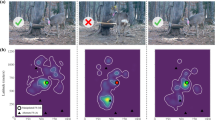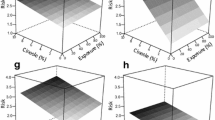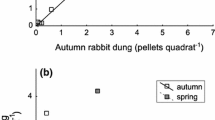Abstract
The relative importance of predation risk and food quality on spatial grazing pressure and activity patterns was tested in a central-place foraging herbivore: the European rabbit. Rabbits grazed less with increasing distance from their burrows into adjacent grassland, thereby creating a gradient of increasing vegetation height and plant biomass and decreasing plant nutrient concentration. When nitrogen concentration was experimentally increased by 150% through fertilizing and mowing, rabbits visited these plots four times more frequently than the untreated control plots. Addition of predator scent (mink pellets) did not result in different patch use by rabbits. The combined addition of fertilizer and mink pellets had the same effect as addition of fertilizer alone. However, the mink pellets changed the temporal activity pattern of rabbits as measured with infrared detectors. Rabbits were predominantly nocturnal but shifted their activities to the day when mink pellets were added, resulting in equal activities during night and day. We conclude that rabbits are sensitive to perceived predation risk, but that this does not influence their spatial grazing pressure. A selection for the highest food quality on the other hand can explain the observed natural rabbit grazing gradient. Food quality was highest close to the burrows, therefore rabbits selecting for high quality food should forage most intensely close to the burrows and only move further away for higher quality items or when the vegetation close to their burrows is depleted. Through intensive grazing close to the burrows rabbits facilitated for themselves either through stimulating fresh protein rich re-growth or the return of nutrients through faeces or both. This is in contrast with central-place foraging theory where intense feeding close to the burrow is assumed to lead to reduced food resources.





Similar content being viewed by others
References
Anderson PK (1985) Foraging range in mice and voles: the role of risk. Can J Zool 64:2645–2653
Arsenault R, Owen-Smith N (2002) Facilitation versus competition in grazing herbivore assemblages. Oikos 97:313–318
Banks PB, Hume ID, Crowe O (1999) Behavioural, morphological and dietary response of rabbits to predation risk from foxes. Oikos 85:247–256
Barreto GR, MacDonald DW (1999) The response of water voles, Arvicola terrestris, to the odours of predators. Anim Behav 57:1107–1112
Bijlsma RG (1993) Ecologische atlas van de Nederlandse roofvogels. Schuyt& Co, Haarlem
Boag B, Mlotkiewicz JA (1994) Effect of odor derived from lion feces on behavior of wild rabbits. J Chem Ecol 20:631–637
Cassini MH (1991) Foraging under predation risk in the wild guinea pig Cavia aperea. Oikos 62:20–24
Charnov EL (1976) Optimal foraging, the marginal value theorem. Theor Popul Biol 9:129–136
De Mazancourt C, Loreau M, Abbadie L (1998) Grazing optimization and nutrient cycling: When do herbivores enhance plant production? Ecology 79:2242–2252
Drent RH, Van der Wal R (1999) Cyclic grazing in vertebrates and the manipulation of the food source. In: Olff H, Brown VK, Drent RH (eds) Herbivores: between plants and predators. Blackwell, Oxford, pp 271–299
Frank DA, McNaughton SJ (1993) Evidence for the promotion of aboveground grassland production by native large herbivores in Yellowstone National Park. Oecologia 96:157–161
Fryxell J (1999) Functional responses to resource complexity: an experimental analysis of foraging by beavers. In: Olff H, Brown VK, Drent RH (eds) Herbivores: between plants and predators. Blackwell, Oxford, pp 371–396
Graham IM, Redpath SM, Thirgood SJ (1995) The diet and breeding density of common buzzards Buteo buteo in relation to indexes of prey abundance. Bird Study 42:165–173
Gross JE, Shipley LA, Hobbs NT, Spalinger DE, Wunder BA (1993) Functional response of herbivores in food-concentrated patches: tests of a mechanistic model. Ecology 74:778–791
Hayes RA, Richardson BJ, Wuyllie SG (2002) Semiochemicals and social signalling in the wild European rabbit in Australia: I Scent profiles of chin gland secretion from the field. J Chem Ecol 28:363–384
Herman CS, Valone TJ (2000) The effect of mammalian predator scent on the foraging behavior of Dipodomys merriami. Oikos 91:139–145
Hik DS, Jefferies RL (1990) Increases in the net above-ground primary production of a salt-marsh forage grass: a test of the predictions of the herbivore-optimization model. J Ecol 78:180–195
Holmes WG (1991) Predation risk affects foraging behaviour of pikas: observational and experimental evidence. Anim Behav 42:111–119
Huntly NJ (1987) Influence of refuging consumers (Pikas: Ochotona princeps) on subalpine meadow vegetation. Ecology 68:274–283
Huntly NJ, Smith AT, Ivins BL (1986) Foraging behaviour of the Pika (Ochotona princeps), with comparisons of grazing versus haying. J Mamm 67:139–148
Iason GR, Manso T, Sim DA, Hartley FG (2002) The functional response does not predict the local distribution of European Rabbits (Oryctolagus cuniculus) on grass swards: experimental evidence. Funct Ecol 16:394–402
Jacob J, Brown JS (2000) Microhabitat use, giving-up densities and temporal activity as short- and long-term anti-predator behaviors in common voles. Oikos 91:131–138
Jedrzejewski W, Rychlik L, Jedrzejewska B (1993) Responses of bank voles to odours of seven species of predators: experimental data and their relevance to natural predator-vole relationships. Oikos 68:251–257
KNMI (2002) Klimaatatlas van Nederland. Elmar, Rijswijk
Kolb HH (1991) Use of burrows and movements by wild rabbits (Oryctolagus cuniculus) on an area of sand dunes. J Appl Ecol 28:879–891
Korpimaki E, Koivunen V, Hakkarainen H (1996) Microhabitat use and behavior of voles under weasel and raptor predation risk: predator facilitation? Behav Ecol 7:30–34
Kotler BP, Blaustein L (1995) Titrating food and safety in a hetrogenous environment: when are risky and safe patches of equal value? Oikos 74:251–258
Kotler BP, Brown JS, Hasson O (1991) Factors affecting gerbil foraging behaviour and rates of owl predation. Ecology 72:2249–2260
Kotler BP, Brown JS, Knight MH (1999) Habitat and patch use by hyraxes: there’s no place like home? Ecol Lett 2:82–88
Lima SL, Dill L (1990) Behavioral decisions made under the risk of predation: a review and prospectus. Can J Zool 68:619–640
Lima SL, Valone TJ (1986) Influence of predation risk on diet selection: a simple example in the grey squirrel. Anim Behav 34:536–544
Lockley RM (1961) Social structure and stress in the rabbit warren. J Anim Ecol 30:385–423
Lode T (1995) Activity pattern of polecats Mustela putorius L in relation to food habits and prey activity. Ethology 100:295–308
Lode T (1997) Trophic status and feeding habits of the European Polecat Mustela putorius L 1758. Mamm Rev 27:177–184
McNaughton SJ (1984) Grazing lawns: animals in herds, plant form, and coevolution. Am Nat 124:863–886
McNaughton SJ, Banyikwa FF, McNaughton MM (1997) Promotion of the cycling of diet-enhancing nutrients by African grazers. Science 278:1798–1800
Orians GH, Pearson NE (1978) On the theory of central place foraging. In: Horn DJ, Stairs GR, Mitchell RD (eds) Analysis of ecological systems. Ohio State University Press, Columbus, pp 155–177
Orrock JL, Danielson BJ, Brinkerhoff RJ (2004) Rodent foraging is affected by indirect, but not by direct, cues of predation risk. Behav Ecol 15:433–437
Pusenius J, Ostfeld RS (2002) Mammalian predator scent, vegetation cover and tree seedling predation by meadow voles. Ecography 25:481–487
Ruess RW, Hik DS, Jefferies RL (1989) The role of lesser snow geese as nitrogen processors in a sub-arctic salt marsh. Oecologia 79:23–29
Schoener TW (1979) Generality of the size-distance relation in models of optimal feeding. Am Nat 114:902–914
Sneddon IA (1991) Latrine use by the european rabbit (Oryctolagus cuniculus). J Mamm 72:769–775
SPSS Inc (2003) SPSS 11.5 edn. SPSS Inc, Chicago
Stahl J, Tolsma PH, Loonen MJJE, Drent RH (2001) Subordinates explore but dominants profit: resource competition in high Arctic barnacle goose flocks. Anim Behav 61:257–264
Stephens DW, Krebs JR (1986) Foraging theory. Princeton University Press, Princeton
Van der Meijden R (1990) Heukels’ Flora van Nederland. Wolters-Noordhoff, Groningen
Van der Wal R, Van de Koppel J, Sagel M (1998) On the relation between herbivore foraging efficiency and plant standing crop: an experiment with barnacle geese. Oikos 82:123–130
Van der Wal R, Van Wijnen H, Van Wieren S, Beucher O, Bos D (2000) On facilitation between herbivores: how Brent Geese profit from brown hares. Ecology 81:969–980
Vander Wal R, Bardgett RD, Harrison KA, Stien A (2004) Vertebrate herbivores and ecosystem control: cascading effects of faeces on tundra ecosystems. Ecography 27:242–252
Ward JF, MacDonald DW, Doncaster CP (1997) Responses of foraging hedgehogs to badger odour. Anim Behav 53:709–720
Wilmshurst JF, Fryxell JM, Bergman CM (2000) The allometry of patch selection in ruminants. Proc R Soc Lond B 267:345–349
Ydenberg RC, Prins HHT (1981) Spring grazing and the manipulation of food quality by barnacle geese. J Appl Ecol 18:443–453
Acknowledgements
We thank the National Forest Service for permission to work in Junner Koeland. The help from Julia Stahl and Wouter van Steenis with the logistics of the experiment was greatly appreciated. We thank the providers of mink pellets for their help with our project. This project was funded by grant no. 805.35.391 from the Netherlands Organisation for Scientific Research (NWO-ALW).
Author information
Authors and Affiliations
Corresponding author
Additional information
Communicated by Roland Brandl
Rights and permissions
About this article
Cite this article
Bakker, E.S., Reiffers, R.C., Olff, H. et al. Experimental manipulation of predation risk and food quality: effect on grazing behaviour in a central-place foraging herbivore. Oecologia 146, 157–167 (2005). https://doi.org/10.1007/s00442-005-0180-7
Received:
Accepted:
Published:
Issue Date:
DOI: https://doi.org/10.1007/s00442-005-0180-7




